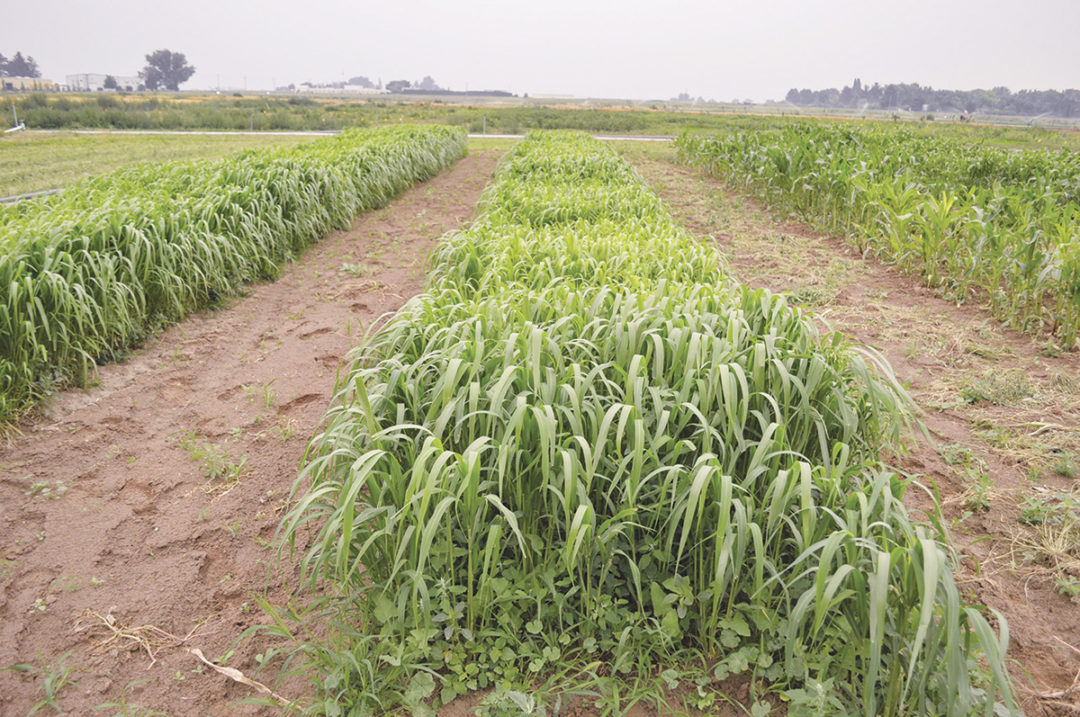When my colleagues and I first started working with cover crops, we all had experience with the usual mix of crops grown in the Magic Valley, either by growing up on farms or working with them in our professional careers. Like most farmers in the region, we had not even heard of some of the cover crop species being discussed in the meetings and magazine articles. I knew that okra was a slimy little vegetable my mom made us eat when we were kids, but what was a phacelia?
Three years ago, I secured a grant to conduct some cover crop work. Part of that work was to grow cover crop demonstration gardens so that we could observe the individual species listed on the National Resources Conservation Service (NRCS) Cover Crop Chart. The chart, set up sort of like the elemental periodic chart we all saw in our high school science classes, breaks various plant species into cool- and warm-season plants, and then further divides them into broad leaves and grasses, and finally, the broad leaves are broken down into legumes and non-legumes.
You can put “NRCS cover crop chart” into your favorite web browser and see examples. There are a few out there, as the original concept has been changed some, and a few region-specific examples have been developed. I like one developed for Wyoming by Marlon Winger, NRCS regional soil health agronomist. There is no sense spending money to plant a species not well adapted to the area. I will use the remainder of my limited space to describe some observations of the various species we have planted and grown or, in a few cases, failed to grow. Keep in mind, we conducted some spring plantings and fall plantings. In the spring, we wanted to observe a full growing season. In the fall, we were looking to see what species might survive and grow in colder weather. Everything was grown at the University of Idaho's Kimberly Research and Extension Center farm. Also, these are only my observations in a limited situation, and this is not replicated research or set-in-stone fact. As they say, your mileage may vary.
I will begin by listing a few species I would not recommend for southern Idaho based on our very limited observations.
-
Okra is slow growing, doesn’t compete well and cannot tolerate the slightest bit of cold.
-
Safflower can grow well, but unless you have the variety "baldy," it is a spiny, miserable plant to deal with, and I can’t imagine livestock enjoying it. This year we grew some baldy, and it grew well but was done after the first cutting (simulated grazing).
-
Sunn hemp is a legume that can produce large amounts of biomass. If you are looking to add a lot of biomass to the soil, this one might work, but it becomes very fibrous as it matures to about 5 1/5-feet tall. I think there are better options for grazing.
-
Buckwheat shows phenomenal rapid and early growth. For some quick ground cover or feed, it could work very well. My caution is that buckwheat, if allowed to produce seed, can become a weed on your property. It will regrow quickly after cutting or grazing. If you grow wheat or barley, you best look at other options.
-
Phacelia did not grow well for us, germinating slowly and being overtaken by weeds almost immediately. However, I have seen phacelia do wonderfully in mixes grown in this area. I will loosely group annual clovers in here too. Our limited experience showed that berseem, Persian and crimson have some promise, but balansa and arrowleaf clovers failed to impress, growing slowly and not competing with weeds; in fact, the arrowleaf was a near total failure on growth after emergence. It seems hard to beat good ol’ red clover in this area, and we have planted a lot of clover in mixes over the last several years.
- Spring lentils grew well early and did regrow well after being cut but started to turn brown and mature midsummer. There are better legumes, in my opinion.
I will add one last pair to this list: hairy and common vetch. They have their place, but they can be hard to terminate and may become weedy on your place.
There are several species that have demonstrated outstanding potential in our trials. The standard cool-season cereals (wheat, barley, oats, cereal rye, triticale) grow well, are proven performers and winter varieties can handle cool weather. Triticale and cereal rye are tops for late-season growth and early season regrowth. I fully understand cereal rye can be a problem in cereal grain systems, and each producer must determine their comfort level. If terminated before it goes to seed, cereal rye can provide a great late- or early season feed source. We have yet to find anything that can provide soil cover when planted late (Oct. 1 or later), better than the winter cereals. I must fully admit, we have yet to find anything that can grow enough to provide reasonable forage when planted after Oct. 1.
Mustards grow well in this area, which is no surprise since we have many weeds in that family that flourish in the Magic Valley. We have grown daikon radish, oilseed radish, turnips, brown mustard, African cabbage and forage collards. All of them grow well, produce lots of biomass or feed, grow back after being cut or grazed, and some will even survive the winter. Forage collards were especially impressive, and if you're looking for a lot of mustard greens in the mix for grazing, that is one I would highly recommend. It will come back strong in the spring, too, and provide early spring graze. Coupled with a winter cereal, and maybe Austrian winter pea, I think it would be a winner for fall and spring grazing between cash crops.
The warm-season grasses we have grown and had great success with include millets, forage sorghum, sorghum-sudan, Egyptian wheat, brown midrib, grazing corn and sunflower. When the heat hits, these species will really produce if they aren’t cut or grazed too short.
In this article, I have only scratched the surface of our observations, and there are several species I didn’t touch on. My main question to a producer is still, “What is your management goal?” Then we can make a cover crop plan from there.








